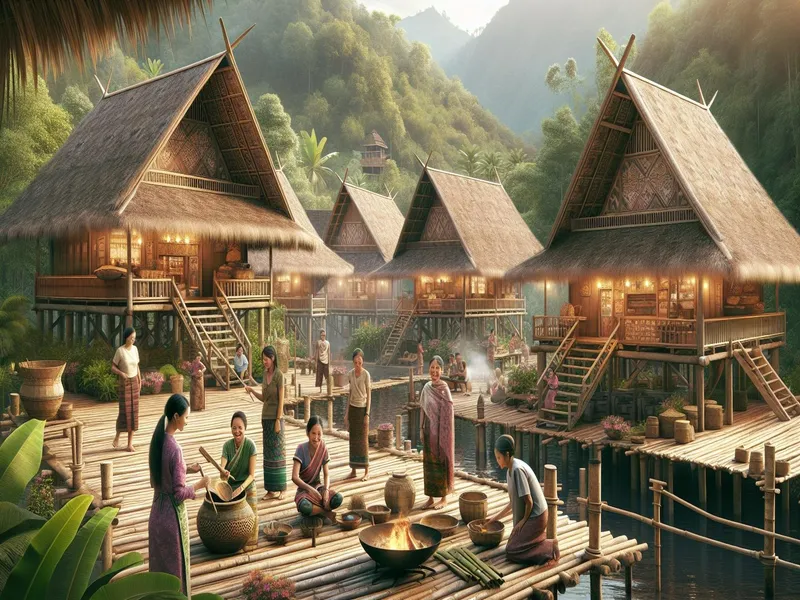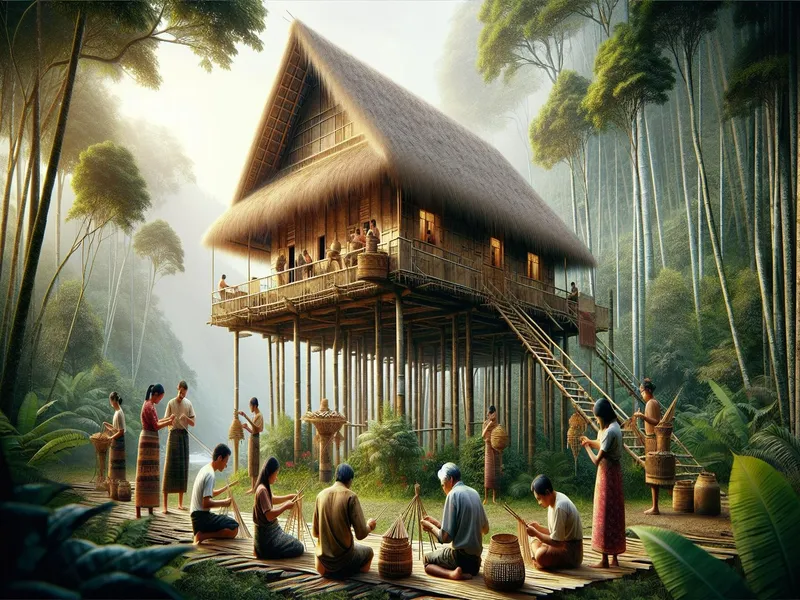Mari Mari Cultural Village in Sabah, Malaysia, where backpackers can explore traditional longhouses, engage in tribal activities, and immerse in Borneo’s heritage.

Overview of Mari Mari Cultural Village
Hey there, fellow backpacker! Let’s jump into the magic that is Mari Mari Cultural Village. Nestled in Sabah, Malaysia, this place feels like stepping into a time machine set to Borneo’s rich past.
What to Expect
First off, you’ll be greeted by friendly guides who double as storytellers. They make history come alive with tales of Borneo’s indigenous tribes. Think of it as an interactive museum where you get to touch and feel everything!
- Traditional Longhouses: These are not just for show. You can walk through them and see how people lived back in the day.
- Bamboo Cooking Demonstrations: Ever wondered how to cook using bamboo? Here you get to watch—and taste!—the process.
- Cultural Performances: Traditional dances and music will leave you tapping your feet. It’s like being at a mini-festival every hour!
Hands-On Activities
One of my favorite parts is the hands-on activities :
- Fire-Making: Learn how to start a fire without matches or lighters. It’s primitive but super cool!
- Tattooing: Don’t worry; it’s temporary! But you get a peek into what traditional tattoos meant for the tribes.
- Blowpipe Shooting: Channel your inner warrior with this fun (and surprisingly challenging) activity.
Quick Comparison Table
| Activity | Duration | Difficulty Level |
|---|---|---|
| Fire-Making | 20 mins | Easy |
| Bamboo Cooking Demo | 30 mins | Moderate |
| Blowpipe Shooting | 15 mins | Medium |
Why Visit?
You might ask, “Why should I add this to my itinerary?” Well:
- It’s affordable
- You get an authentic cultural experience
- Perfect for Instagram shots
When I visited, I felt like Indiana Jones exploring untouched lands (minus the danger). Plus, you’ll gain some serious bragging rights among your travel buddies.
Packing Tips
To make the most out of your visit:
- Wear comfy shoes
- Bring a water bottle (it gets hot!)
- Don’t forget sunscreen
History and Significance

So, you’re curious about the backstory of Mari Mari Cultural Village? Let’s immerse. Nestled in Sabah, Malaysia, this village isn’t just a tourist spot—it’s a living testament to Borneo’s indigenous heritage.
Origins and Development
Mari Mari Cultural Village sprang to life with a mission: preserve the traditional lifestyles of Sabah’s ethnic groups. Established over 15 years ago, it was designed to give us an authentic peek into the past. Think of it as a time machine set amidst lush greenery.
- Traditional Longhouses: Each tribe has its own longhouse representing their unique architecture.
- Hands-on Activities: You’ll find bamboo cooking demonstrations and fire-making sessions that make history come alive.
I remember my first visit—the aroma of bamboo rice cooking over open flames was unforgettable.
Cultural Importance
This village isn’t just for show; it’s a cultural hub. Indigenous tribes like the Kadazan-Dusun, Rungus, Lundayeh, Bajau, and Murut maintain their traditions here. Visiting isn’t just sightseeing—it’s participating in age-old practices.
- Tribal Dances: Witnessing these is like stepping into another era.
- Storytelling Sessions: Guides share legends passed down through generations.
When I tried blowpipe shooting for the first time, I felt like I’d been transported back centuries. It’s these experiences that make Mari Mari more than just a stop on your itinerary—it’s an essential part of understanding Borneo’s soul.
Remember: pack comfortable shoes and bring sunscreen! This journey through history involves some walking under the tropical sun. ☀️
Attractions and Activities

At Mari Mari Cultural Village in Sabah, Malaysia, you’ll find an array of attractions and activities that dive deep into Borneo’s indigenous heritage. Let me walk you through some highlights.
Traditional Houses
Imagine strolling through lush greenery and suddenly finding yourself stepping into a different world inside traditional longhouses. Each one represents a distinct tribe like the Kadazan-Dusun or Rungus. When I first entered the Kadazan-Dusun house, it felt like walking back in time. The longhouse is built on stilts with bamboo walls and thatched roofs—a true testament to sustainable living.
Pro Tip: Don’t miss out on the unique architecture features:
- Rungus Longhouse: Notice its length—some stretch over 200 feet!
- Bajau House: Elevated high above the ground to avoid flooding.
You can actually touch, feel, and even try your hand at using some of their daily tools. It’s not just seeing; it’s experiencing history firsthand!
Crafts and Demonstrations
If you’re anything like me, hands-on experiences are where memories are made. At Mari Mari Cultural Village, you get to do just that with various crafts and demonstrations.
One highlight? Bamboo cooking! Watching how they cook rice in bamboo over an open fire made me appreciate their ingenuity (and made me hungry). Then there’s blowpipe shooting—it’s way harder than it looks but super fun!
Here’s what you should definitely check out:
- Fire-Making Demo: Learn ancient techniques of starting a fire without matches.
- Temporary Tattooing: Get inked with natural dyes that wash off in days—perfect for testing new looks without commitment.
Quick Packing Tip: Grab a small backpack with essentials—comfortable shoes, water bottle, sunscreen—and leave room for souvenirs!
When I tried my hand at weaving a simple basket under the guidance of a local artisan, I realized how intricate their craftsmanship truly is. These moments aren’t just educational—they’re unforgettable snapshots of cultural immersion.
So pack light but bring your curiosity because every corner of this village has something extraordinary waiting for you!
Visitor Experience
Exploring Mari Mari Cultural Village is like stepping into a living history book. You get to see, touch, and even taste the rich heritage of Borneo’s indigenous tribes.
Guided Tours
Guided tours are the heart of the Mari Mari experience. These knowledgeable guides make everything come alive with their stories and insights. When I visited, my guide was a local from one of the tribes, which made it feel incredibly authentic. They took us through each longhouse, explaining unique architectural quirks and traditional practices.
Highlights of the tour:
- Storytelling: Each tribe has its own legends.
- Demonstrations: See fire-making and bamboo cooking up close.
- Q&A sessions: Ask anything!
The tours usually last around two hours—plenty of time to soak in all the details without feeling rushed. Trust me, you’ll leave with a newfound respect for these ancient cultures.
Cultural Performances
Cultural performances at Mari Mari are nothing short of magical. Picture this: you’re sitting under a canopy of trees as tribal dancers perform intricate steps to rhythmic drumbeats. It’s both mesmerizing and educational.
What you’ll see:
- Traditional dances from various tribes
- Music performances featuring indigenous instruments
- Interactive segments where you can join in
When I joined in on a dance performance (yes, they encourage participation), it felt surreal yet exciting! The energy is infectious; you can’t help but smile ear-to-ear.
Practical Information
Hey traveler! Ready to jump into some practical tips for visiting Mari Mari Cultural Village? Let me guide you through the essentials to make your trip smooth and memorable. ✨
How to Get There
Getting to Mari Mari Cultural Village is a breeze if you know how. Located about 25 minutes from Kota Kinabalu, the capital of Sabah, it’s easily accessible by car or organized tour.
- Taxi/Grab: If you’re in KK city, hail a taxi or use Grab (the Southeast Asian equivalent of Uber). It’s affordable and hassle-free.
- Organized Tours: Many local operators offer half-day tours with pick-up and drop-off services. This option includes transportation and ensures you won’t miss anything!
- Self-drive: For those who love road trips (like me!), renting a car gives you flexibility. The drive is scenic, passing through lush greenery. Just pop “Mari Mari Cultural Village” into Google Maps, and you’re good to go!
When I took a Grab, the driver shared stories about his own village life—totally added local flavor to my trip!
Ticket Prices and Hours
Now let’s talk tickets and timings. Knowing this helps plan your day without any hiccups.
- Ticket Prices: As of 2023:
- Adults: MYR 85 (~$20)
- Children (5-11 years): MYR 70 (~$16)
You might find discounts online or via tour packages, so keep an eye out!
- Operating Hours:
- Open daily
- Tour sessions usually at:
10 AM, 2 PM, 7 PM
I suggest booking ahead, especially during peak seasons like school holidays—this place gets popular fast!
Here’s what I did on my visit:
- Booked the morning session
- Enjoyed lunch afterward at one of KK’s awesome cafes ☕️
- Had plenty of time left for more sightseeing in the afternoon!
Mari Mari Cultural Village is more than just a tourist attraction; it’s an immersive journey into the heart of Borneo’s indigenous heritage. With its hands-on activities and engaging guides, it offers a rare opportunity to experience age-old traditions firsthand. Whether you’re interested in cultural history or simply looking for an unforgettable adventure, this village has something unique to offer.
The convenience of its location near Kota Kinabalu and the affordability of tickets make it accessible for all travelers. Don’t forget to pack comfortable shoes, a water bottle, and sunscreen to ensure you get the most out of your visit. This trip promises not only Instagram-worthy moments but also memories that will last a lifetime.